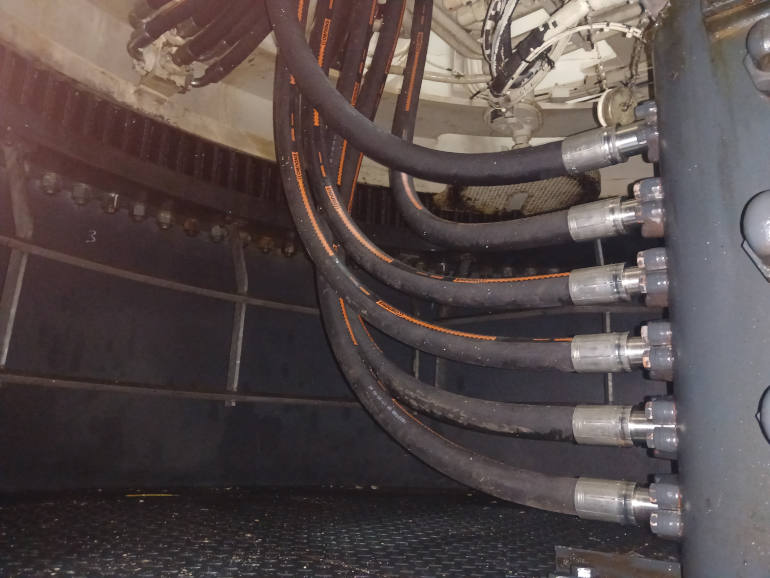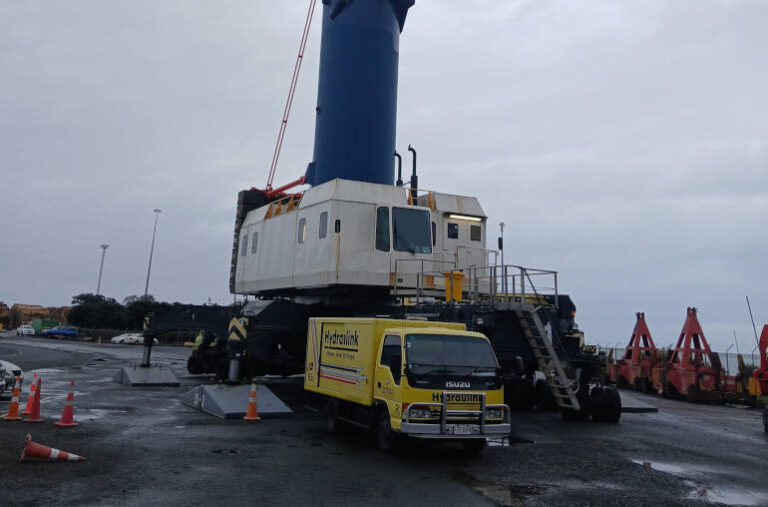Busy ports cannot afford downtime on critical equipment — particularly heavy-lift cranes that are called on to handle large, urgent jobs with little notice. These machines must be maintained in peak operating condition to ensure worker safety and to keep cargo moving efficiently.
At Port Taranaki in New Zealand, this challenge was put to the test earlier this year when the port’s team turned to Hydraulink network distributor Hydraulic Solutions Taranaki. Their task was to carry out essential maintenance on the port’s rubber-tyred, 200-tonne Liebherr LHM400 crane — a workhorse constantly in demand for moving everything from standard containers and logs to offshore oil and gas infrastructure.
According to Hydraulic Solutions Taranaki Managing Director, Duncan MacIver, the scope of work was significant.
“The complexity of this job was that there were dozens of hydraulic hoses to inspect and replace — a total of 76 hoses, some located deep in the dark entrails of the machine,” he explained. “We were also under considerable time pressure, with the crane needing to be back in service and fully commissioned within a week.”
Adding to the complexity, the crane couldn’t be taken offline for the entire duration of the maintenance. “We couldn’t just go in and do all the hose inspections and replacements at once,” Duncan said. “The crane might be called into service at any time. So we had to complete the work in stages — five or six hoses at a time — so it could quickly return to operation and meet port demands.”

Port Taranaki, the only deep-water port on New Zealand’s west coast, plays a critical role in supporting the import and export needs of the region’s industries. “They are very conscious of their importance to market access and the need to provide a safe environment at all times,” Duncan said. His team brought decades of experience working with cranes and heavy plant equipment across sectors including construction, resources, and public infrastructure.
To meet the tight timeframe, Hydraulic Solutions Taranaki deployed a three-person team working in unison. “One team member inspected and removed hoses, another replaced and installed equipment, while the third double-checked to ensure every fitting and hose met specification,” Duncan said. This coordinated approach helped deliver the job efficiently and effectively.
The success of the project was also supported by Hydraulink’s product range and logistics. “Drawing on Hydraulink’s world-class hose and fitting products, along with their specifying and installation experience, meant we could have the right gear on site at the right time,” Duncan said. “This combination of skilled manpower, product availability, and flexibility allowed us to work with a client whose scope and budget needed to adapt as requirements evolved.”
The team’s preparation paid off. “The hoses were on site on Monday, and our crew progressively advanced through the work,” Duncan said. “We finished ahead of schedule on Thursday and completed commissioning on Friday morning.”
Hydraulink New Zealand sales manager, Rob Naughton, was quick to praise the team’s professionalism. “Duncan and his team are excellent operators who understand the value of uptime to clients,” he said. “They know that critical equipment like ship-loading cranes must be ready at all times to safely carry out a wide range of tasks to world-class standards.”
Hydraulink, which operates under the banner “Best Under Pressure,” has more than 400 service points across Australia, New Zealand, and South Asia. The company operates a large fleet of mobile service vehicles that perform high-standard work on client sites, backed by a network of engineering workshops in strategic locations.
For busy ports like Port Taranaki, partnerships with suppliers who understand the critical nature of uptime, safety, and flexibility are essential. Hydraulink’s support helped ensure the port’s heavy-lift crane remained operational and ready to handle whatever job came next — without delay.






